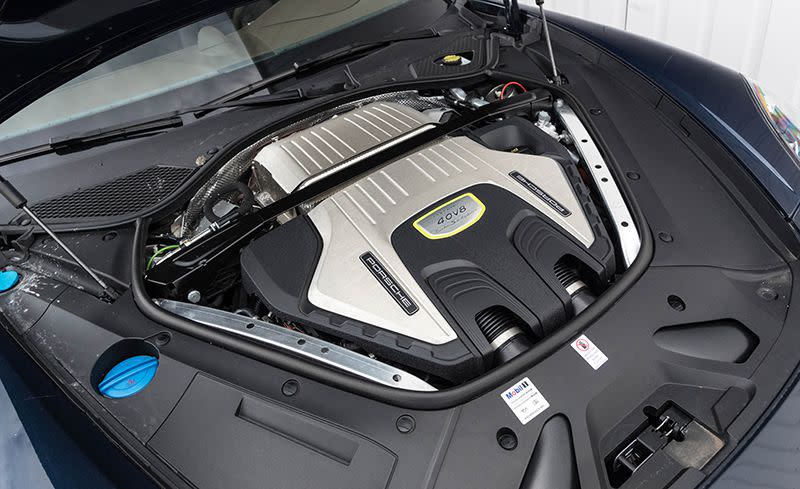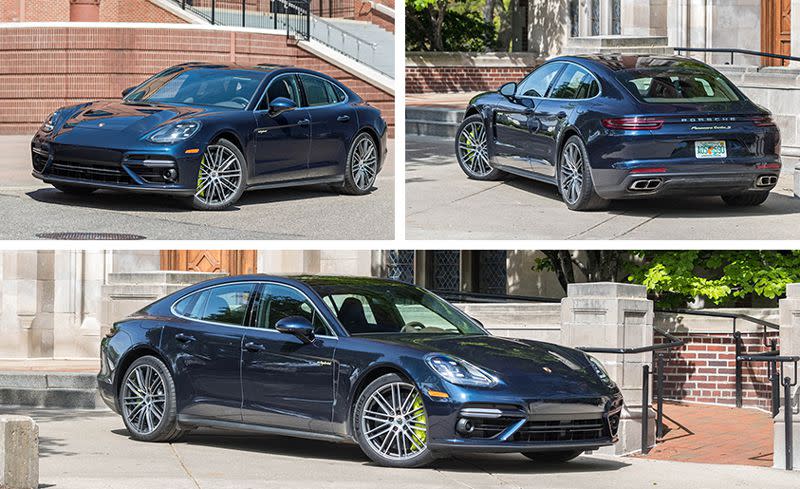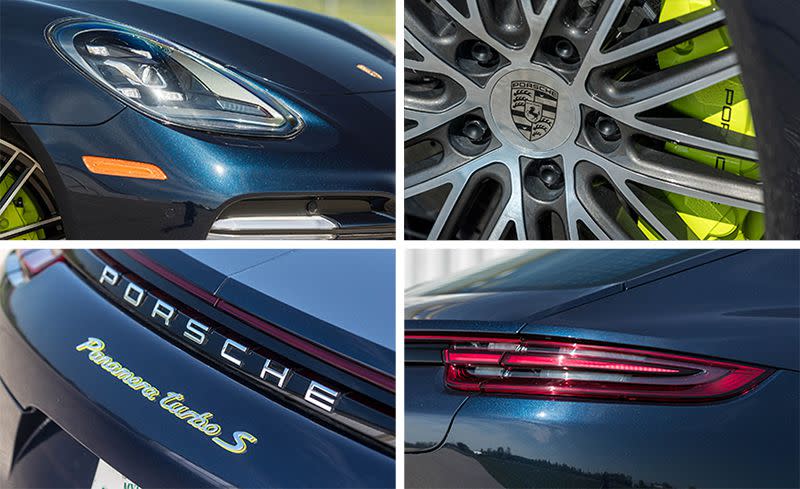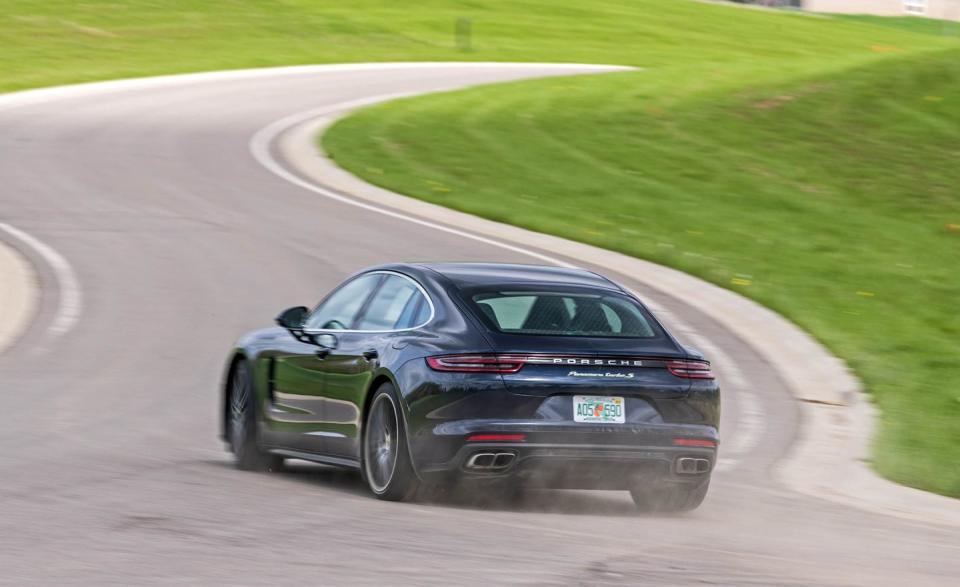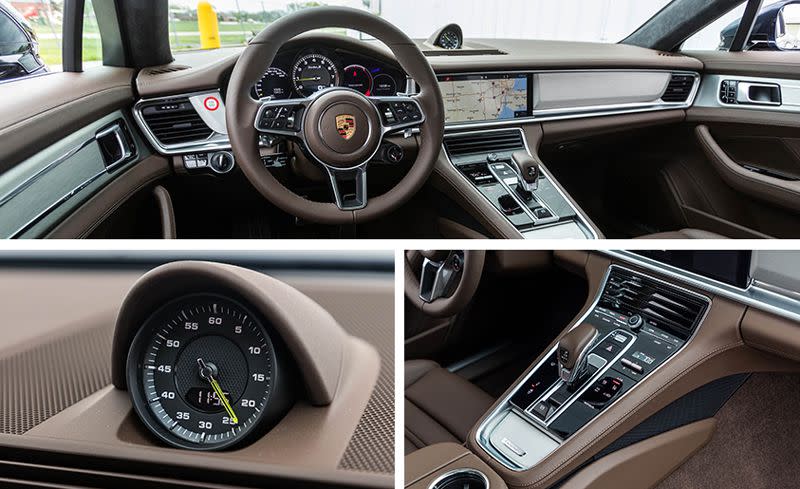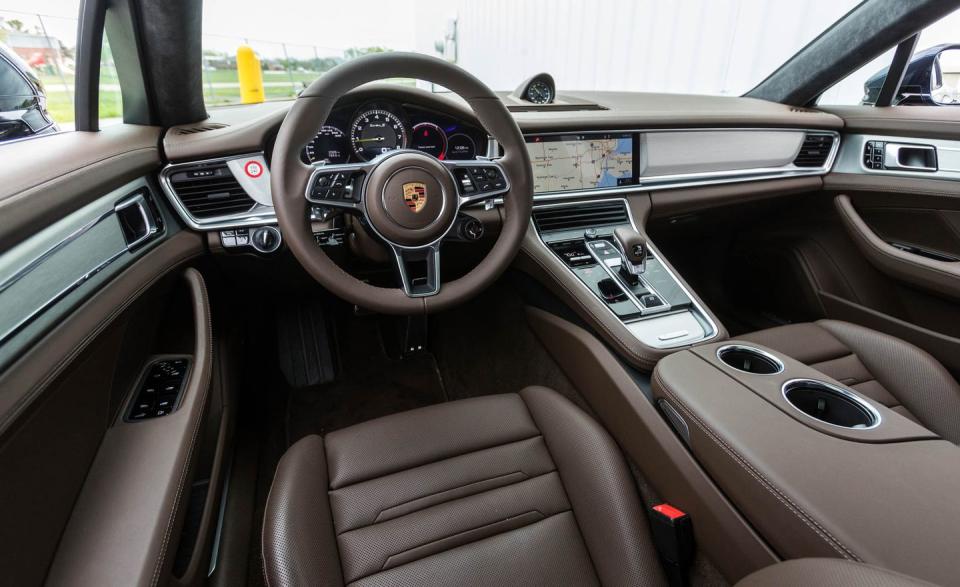The 2018 Porsche Panamera Turbo S E-Hybrid Is Capable but Clinical
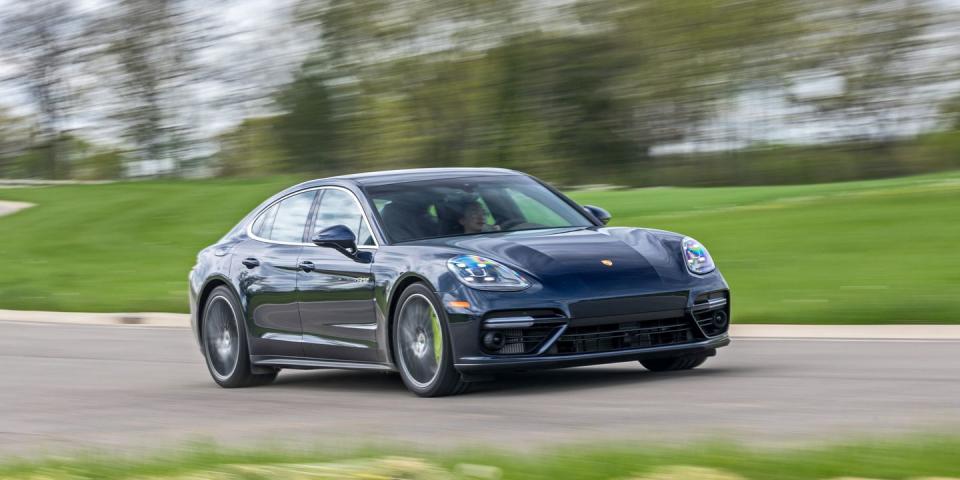
Just as Bob Dylan went electric, so, too, is the Porsche Panamera. The Turbo S E-Hybrid is a 680-hp gasoline-electric beast that now sits at the top of the lineup as the most powerful Panamera model currently sold.
Like the nonhybrid Turbo, the Turbo S E-Hybrid features a 550-hp twin-turbocharged 4.0-liter V-8. The hybrid, however, supplements that with a 136-hp electric motor sandwiched between the engine and the eight-speed PDK dual-clutch automatic transmission. (Due to the different output curves of the two power sources, the Turbo S E-Hybrid’s 680 total horsepower is six less than that of the combined outputs of the V-8 engine and the electric motor.)
Thanks to the immediacy of the electric motor’s 295 lb-ft of torque combined with the monstrous 567 lb-ft of twist produced by the V-8, the Turbo S E-Hybrid rockets forward with the brutality of an NFL linebacker. Even with all-wheel drive and sticky Michelin Pilot Sport 4 tires, the Turbo S E-Hybrid scrambles for traction as it leaps off the line, powering to 60 mph in just 2.9 seconds and through the quarter-mile after 11.1 seconds at 125 mph.
Compared with the Panamera Turbo, which hits the mile-a-minute mark in 3.0 seconds and needs 11.3 seconds to cover 1320 feet of tarmac and hit 122 mph, the hybrid’s performance gains may seem minimal. However, the actuality of flat-footing the hybrid Panamera is a far different experience. With the electric motor covering up the engine’s initial turbo lag, the Turbo S E-Hybrid never hesitates when called upon.
Electric Avenue
Feeding a steady diet of electrons to the electric motor is a 14.1-kWh lithium-ion battery pack. The battery provides enough juice to enable an EPA-estimated 14 miles of EV driving before the V-8 fires up. And in the default E-Power mode, the electric motor is powerful enough to move the Porsche with reasonable pep at speeds as high as 86 mph.
Recharging the battery pack takes almost 13 hours on a standard 120-volt outlet, but switching to a 240-volt source lowers that time to a more reasonable four hours with the standard 3.6-kW onboard charger. Spend $840 for the optional 7.2-kW charger included in our test car, and the battery can be fully charged in less than two-and-a-half hours. In motion, both E-Charge and E-Hold functions are available. The former uses the gas engine to charge the battery pack to its maximum capacity, while the latter maintains the battery pack’s charge for later use.
Once the battery is drained of juice, the Panamera’s system switches to the Hybrid Auto setting, which enables the gas engine and electric motor to juggle their respective duties in order to maximize efficiency. A twist of the steering-wheel-mounted driving-mode switch (part of the standard Sport Chrono package, which also includes a dashboard-mounted stopwatch) enables the harder-edged Sport and Sport Plus settings. Both keep the V-8 running to charge the battery pack in order to ensure the electric motor is able to provide its full assistance when called upon.
Dynamic Dud
Regardless of driving mode, the Turbo S E-Hybrid segues between power sources with the deft precision of Dylan fingering the fretboard of a Fender Stratocaster. Sadly, the same cannot be said of the brake pedal, which transitions between regenerative and friction braking with the clumsiness of a first-time music student. Annoyingly, there’s also no way to increase the amount of regenerative braking force offered by lifting off the accelerator pedal.
Despite the awkward brake modulation, the Turbo S E-Hybrid is hardly short on bite, and the car comes standard with a set of mammoth 16.5-inch front and 16.1-inch rear carbon-ceramic brake rotors clamped by 10-piston front and four-piston rear calipers wearing Acid Green paint. (Porsche also applies Acid Green accents to the Turbo S E-Hybrid’s exterior badging, although this can be deleted and the brake-caliper color changed if one desires.) The big binders brought the Porsche to a stop from 70 mph in a fade-free 152 feet-a feat all the more impressive given the hybrid’s 5315-pound curb weight, a hefty 722 more than the Panamera Turbo.
The Turbo S E-Hybrid’s battery pack makes up approximately 287 pounds of its added mass. Positioned below the cargo floor, the battery pack cuts four cubic feet from the Panamera’s cargo hold. Even so, the Porsche’s 14 cubic feet of available cargo space is still perfectly adequate.
The battery pack’s position does benefit weight distribution, and the Turbo S E-Hybrid places 51.3 percent of its mass on the rear axle. Conversely, the Panamera Turbo has 53.5 percent of its bulk over the front wheels. Factor in a 1.01-g performance around our 300-foot skidpad (the Turbo pulled “only” 0.94 g), and the Panamera Turbo S E-Hybrid is a standard bearer in vehicle capability.
It is not a standard bearer in terms of involvement, however. Although standard features such as brake-based torque-vectoring and adaptive dampers and air springs-as well as a $1340 rear-wheel steering system-help the Turbo S E-Hybrid make the most of its extensive grip, the car just doesn’t provide the engaging driving experience of other Porsche models, and its dynamics lack the tactility of the company’s sports cars.
Even the standard Panamera Turbo is more fun to drive than this gasoline-electric hybrid, which moves with an inorganic, video-game-like quality. The light but direct steering is as informative as Reggie Miller doing color commentary on an NBA broadcast (read: not very), while the various electronic chassis controls, which can perform tasks such as altering the spring rates and adjusting the stiffness of the anti-roll bars, take away from driver involvement.
It may be that only Porsche aficionados will find the driving dynamics of the Panamera Turbo S E-Hybrid dispiriting. Buyers seeking a high-performance luxury sedan will surely be wowed by the truly awesome performance.
First-Class Flight
With a base price of $185,450, the Turbo S E-Hybrid costs $34,400 more than the lesser Panamera Turbo. Even at that price, the high-performance hybrid Porsche feels every bit as rich as its cost-of-entry suggests, with high-end materials and top-notch build quality defining the car’s cabin. Well-bolstered 14-way power seats offer long-haul comfort for those up front, while those in back are treated to individual seats bisected by a center console. Those in search of additional seating capacity can spend $1000 on a three-across rear bench.
This Night Blue Metallic example skipped that option but did come with $2880 worth of massaging front seats and ventilated front and rear seats (seat heaters are standard). Additionally, this car included eight-way power operation for the rear seats at a cost of $2310, four-zone climate control (in place of the standard two-zone setup) for $1410, a pair of power rear sunshades for $880, soft-close doors for $780, and a $280 heated steering wheel. Another $5370 bought the Assistance package, which added lane-keeping assist, a night-vision camera, and Porsche’s new InnoDrive adaptive cruise control, which uses the navigation’s map database along with radar and video feeds to accelerate, brake, and select the right gear in preparation for conditions as far as 1.8 miles ahead. We found InnoDrive a seamless partner that never called undue attention to itself.
Despite the craftsmanship and comforts of its cockpit, the Panamera Turbo S E-Hybrid suffers ergonomic deficiencies that drew the ire of our staff. Our grievances largely centered around the infotainment system and its 12.3-inch central touchscreen, which offers clear and crisp graphics but confusing and unintuitive menus. The redundant controls on the center console are no less frustrating, as many of the touch-sensitive buttons are difficult to find without taking one’s eyes off the road. Meanwhile, the air vents forgo manual directional controls for irksome electronic units that require using a separate menu on the touchscreen.
Details unique to the Turbo S E-Hybrid include Acid Green gauge needles for the tachometer and dashboard-mounted stopwatch, as well as powertrain-specific display menus for the touchscreen and gauge-cluster displays. As in other Panameras, the Turbo S E-Hybrid features an analog tachometer flanked by a pair of 7.0-inch screens, both of which seem underutilized. Although we appreciated the integration of a full navigation map, we lamented the limited amount of audio information that could be displayed within the cluster screens.
Electric, Not Eclectic
Much like the folk fans who were disappointed to see Bob Dylan pick up an electric guitar and embrace mainstream rock ’n’ roll, we are not entirely sold on the Porsche Panamera Turbo S E-Hybrid, which is awash with modern powertrain tech but sacrifices the soul-stirring engagement on which Porsche built its reputation. Whether we like it or not, though, Porsche is going electric. We can only hope future hybrid and full-electric models from Porsche can find some of the magic found in the driver-focused 918 Spyder and avoid some of this Panamera’s clinical feel.
('You Might Also Like',)

 Yahoo Autos
Yahoo Autos 